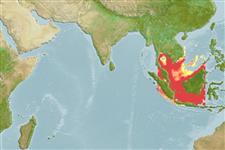>
Clupeiformes (Herrings) >
Engraulidae (Anchovies) > Coiliinae
Etymology: Setipinna: Latin, septem = seven + Latin, pinna, -ae = fin.
More on author: Bleeker.
Environment: milieu / climate zone / depth range / distribution range
Écologie
marin; eau douce; saumâtre. Tropical; 19°N - 8°S, 99°E - 118°E (Ref. 189)
Western Central Pacific: Thailand south to Java, including rivers, e.g., the Chao Praya in Thailand and the Rokan, Kapuas and Barito in Indonesia and the Mekong River system.
Taille / Poids / Âge
Maturity: Lm ? range ? - ? cm
Max length : 33.0 cm SL mâle / non sexé; (Ref. 30857); common length : 19.0 cm SL mâle / non sexé; (Ref. 9822)
Description synthétique
Morphologie | Morphométrie
Épines dorsales (Total): 0; Épines anales 0; Rayons mous anaux: 45 - 53. Belly with 21 to 26 + 8 to 10 = 30 to 35 keeled scutes from isthmus to anus. Lower gill rakers with serrae rather large, spiky, but not distinctly clumped. Pectoral filament short or even absent, never reaching even to anus. Gill cover and main part of pectoral fin often dusky or jet black; other fins pale to bright yellow (Ref. 189). Origin of anal fin in front of origin of the dorsal fin (Ref. 43281).
This species was recorded up rivers at 90, 150 and 210 km from the sea, but it is not known if these are permanent freshwater populations or migrants from the sea. At least small numbers enter artisanal river and lake fisheries (Ref. 9822). Found in large rivers far upstream from the estuary (Ref. 12693). Feeds mainly on insect larvae and small fishes. Used to make prahoc (Ref. 12693).
Life cycle and mating behavior
Maturité | Reproduction | Frai | Œufs | Fécondité | Larves
Wongratana, T., T.A. Munroe and M. Nizinski, 1999. Order Clupeiformes. Engraulidae. Anchovies. p. 1698-1753. In K.E. Carpenter and V.H. Niem (eds.) FAO species identification guide for fishery purposes. The living marine resources of the WCP. Vol. 3. Batoid fishes, chimaeras and bony fishes part 1 (Elopidae to Linophrynidae). FAO, Rome. (Ref. 9822)
Statut dans la liste rouge de l'IUCN (Ref. 130435)
Menace pour l'homme
Harmless
Utilisations par l'homme
Pêcheries: pêcheries vivrières
Plus d'informations
Noms communsSynonymesMétabolismePrédateursÉcotoxicologieReproductionMaturitéFraiRassemblement de ponteFéconditéŒufsDéveloppement de l'œuf
RéférencesAquacultureProfil d'aquacultureSouchesGénétiqueElectrophoresesHéritabilitéPathologiesTraitementNutrientsMass conversion
CollaborateursImagesStamps, Coins Misc.SonsCiguateraVitesseType de nageSurface branchialeOtolithesCerveauxVision
Outils
Articles particuliers
Télécharger en XML
Sources Internet
Estimates based on models
Preferred temperature (Ref.
123201): 24.1 - 28.6, mean 28 °C (based on 430 cells).
Phylogenetic diversity index (Ref.
82804): PD
50 = 0.5039 [Uniqueness, from 0.5 = low to 2.0 = high].
Bayesian length-weight: a=0.00525 (0.00303 - 0.00910), b=3.03 (2.88 - 3.18), in cm total length, based on LWR estimates for this species & (Sub)family-body (Ref.
93245).
Niveau trophique (Ref.
69278): 3.9 ±0.63 se; based on food items.
Résilience (Ref.
120179): Milieu, temps minimum de doublement de population : 1,4 à 4,4 années (Preliminary K or Fecundity.).
Fishing Vulnerability (Ref.
59153): Low to moderate vulnerability (30 of 100).
